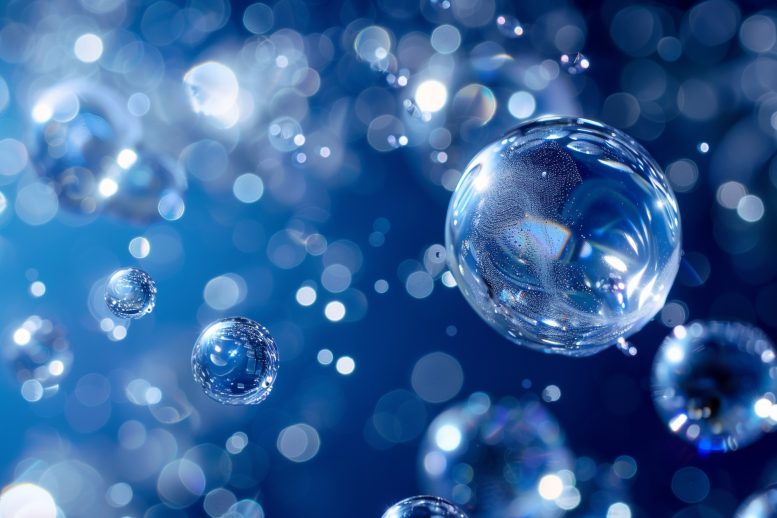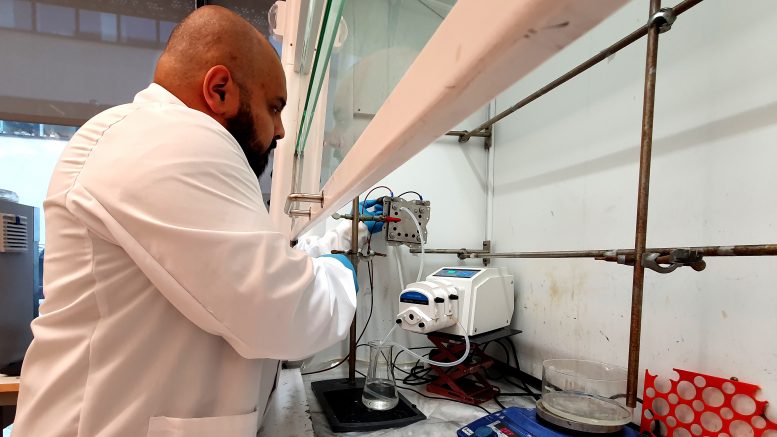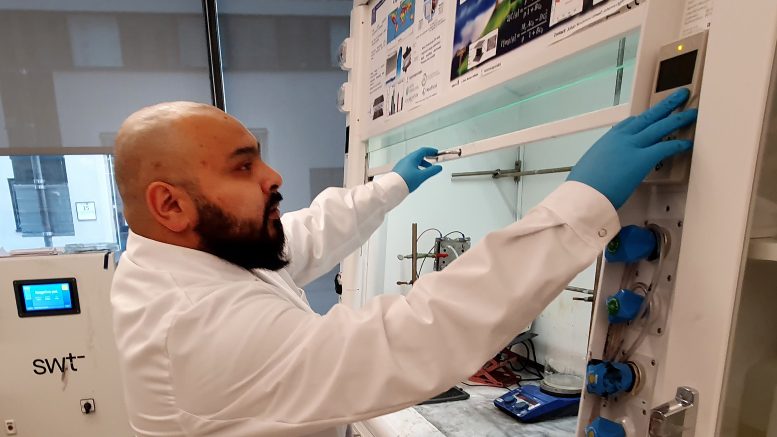
Scientists in Sweden have developed an innovative method for generating hydrogen energy with enhanced efficiency. This process separates water into oxygen and hydrogen, eliminating the hazardous possibility of the two gases combining.
Developed at KTH Royal Institute of Technology in Stockholm, the new method decouples the standard electrolysis process for producing hydrogen gas, which splits water molecules by applying an electric current. In contrast with prevailing systems, it produces the resulting oxygen and hydrogen gases separately rather than simultaneously in the same cell, where they need to be separated by membrane barriers
That separation eliminates the possibility of the gases mixing with the risk of explosions, says researcher Esteban Toledo, a Ph.D. student at KTH who co-authored the paper published today in Science Advances along with Joydeep Dutta, professor of applied physics at KTH. It also eliminates the need for rare Earth metals.
The two researchers patented the system and a company, Caplyzer AB, was formed through KTH Innovation to scale the technology.

Commercial Viability and Efficiency
Dutta says the hydrogen gas Faradaic efficiency was shown to be 99 percent. The researchers also report that lab tests showed no apparent electrode degradation as a result of long-term tests, which is important for commercial applications.
Producing hydrogen from water always generates oxygen. A typical alkaline electrolyzer has a positive and negative electrode paired up inside a chamber of alkaline water, separated by an ion-permeable barrier. When an electric current is applied, water reacts at the cathode by forming hydrogen and negatively charged hydroxide ions which diffuse through the barrier to the anode to produce oxygen.
But the barrier causes resistance and if the electric charge fluctuates, the risk of an explosive mix between oxygen and hydrogen is heightened.
Toledo says re-conceptualizing water electrolysis sets the stage for a more reliable form of green energy production, incorporating intermittent sources such as solar or wind.
“Since we don’t risk mixing the gases, we can operate over a wider range of input power,” he says. “It’s much easier then to couple with renewable energies that generally provides variable power.”

The simultaneous production of gases is circumvented by replacing one of the electrodes with a supercapacitive electrode made from carbon. These electrodes alternately store and release ions, effectively separating hydrogen and oxygen production.
When the electrode is negatively charged and producing hydrogen, the supercapacitor stores energy-rich hydroxide (OH) ions. When the direction of the current is swapped, the supercapacitor releases the absorbed OH, and oxygen is produced at the now-positive electrode.
“One electrode does the evolution of both oxygen and hydrogen,” Dutta says. “It’s a lot like a rechargeable battery producing hydrogen – alternately charging and discharging. It’s all about completing the circuit.”
Reference: “Decoupled supercapacitive electrolyzer for membrane-free water splitting” by Esteban A. Toledo-Carrillo, Mario García-Rodríguez, Lorena M. Sánchez-Moren and Joydeep Dutta, 6 March 2024, Science Advances.
DOI: 10.1126/sciadv.adi3180
The research was funded in part by Vinnova and Åforsk.
Never miss a breakthrough: Join the SciTechDaily newsletter.
8 Comments
It is a very good alternative for producing h2 frim water
On what do you base your opinion? The only number provided is the “Faradaic efficiency,” without an explanation of its importance or how it compares to older methods.
This is all great,but we need it now always seems like we are there and aren’t. Thanks to all for your efforts 🙂
“But the barrier causes resistance and if the electric charge fluctuates, the risk of an explosive mix between oxygen and hydrogen is heightened.”
That shouldn’t be an issue with modern electronics. Computers require highly stable direct-current power and it is routine to design power supplies that deliver stable voltage or current.
The explosion risk from spatial separation failure is replaced with explosion risk from temporal separation failure. I remain to be convinced that the latter is better.
The single “99%” I know it’s that 99% of people never made a simple electrolysis experiments, unless in theory, to give any opinion about! The true breakthrough would be a method to increase the rate of splitting water with less current! To keep the gasses splitted isn’t the biggest problem!
So in effect each cell has to be purged of the previous gas before reversal or potentially explosive mixing will occur. If anything this sounds worse than existing cells.
I have for the past 4 years and 25000 Kms been using H2 Electrolysis as a Fuel Burn Enhancement for my 2.5L Automatic 4×4 Diesel Camper Van with very good reduced Emissions, plus a 25 to 30% Fuel reduction.
My recent Diesel Campervan MOT ( TUV ) Test shows an Exhaust Gas Reading of 33 Mg / Km against the Allowable Pass Reading of 150 Mg / Km, this indicates a Factor of 4.5 times Lower CO2 Emissions. These Emissions are similar to my 1000cc 3 Cylinder Suzuki Swift Hybrid vehicle’s MOT reading showing 30 Mg / Km, however the Susuki is 23 years younger and has a two and a half times smaller Petrol Engine.
I have also experimented with self made H2 Kits on my Suzuki Swift Hybrid vehicle initially with surprizing performance results, however these were short lived due to material degradation and leakage problems. I do intend to continue with a Dry Cell alternative.
I think that retro fitting of H2 Electrolysis is a Safe and Shorter Term Alternative for I C Engine CO2 Emissions Reduction. I have achieved this by means of a Hoffman style H2 Kit, which separates the Hydrogen and Oxygen production by means of 2 seperate vessels linked together by the Electrolyte. Only the H2 from the Negatively connected vessel is fed into the Inlet Manifold, the O2 from the Possively connected vessel is dumped.
A minor alteration to the Kit was necessary due to the failure of the PWM an Amperage Control Unit that was supplied with the Kit. After trying a few similar PWM boxes I discovered a more reliable substitute, one with 0 to 100% Amperage adjustment. The kit after modifying has proved very reliable and requires very little Maintenance.
My early Petrochemical design experience was gained with Associated Octel the manufacturers of TEL & TML the infamous Petroleum Lead Additive. During the past 4 years I have also Lobbied Universities and Marine Engine manufacturers with very little success. However One of my Lobby contacts is Dr. Benjamin Jager from The Fraunenhoff Institute, Germany. I mention F I G as they were one of the few bodies who replied to my Lobbying, they have developed an Ethanol based H2 Marine Fuel together with a high density H2 saturated Gel.
Regards: Malcolm Yates